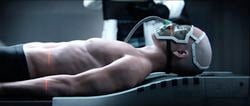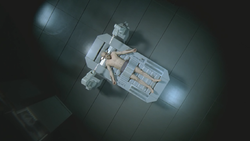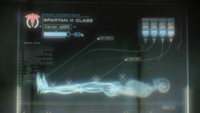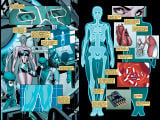Biological augmentation: Difference between revisions
From Halopedia, the Halo wiki
(→Sources: replaced: <references/> → {{Ref/Sources}}) |
(Added ancient human section) |
||
| Line 41: | Line 41: | ||
Following the Human-Covenant War any sufficiently wealthy private party could replicate the effects of the Spartan augmentations. However, cheaper and more invasive augmentations with unknown medical drawbacks and psychological costs were considered more viable given the high cost and amount of effort required to create actual Spartans.<ref>[https://www.halowaypoint.com/en-us/community/blog-posts/canon-fodder-armory-amore 1/22/2016: Armory Amore]</ref> | Following the Human-Covenant War any sufficiently wealthy private party could replicate the effects of the Spartan augmentations. However, cheaper and more invasive augmentations with unknown medical drawbacks and psychological costs were considered more viable given the high cost and amount of effort required to create actual Spartans.<ref>[https://www.halowaypoint.com/en-us/community/blog-posts/canon-fodder-armory-amore 1/22/2016: Armory Amore]</ref> | ||
==Ancient Human== | |||
Given the lifespan of Forthencho (at least a thousand years) and the physical, neurological and combat capabilities of the Forerunners particularly the Warrior-Servants rate and their Promethean class, it is likely the humans (or at least their military) of the ancient human interstellar civilization used various forms of augmentation to augment their bodies so as to be more efficient and durable in combat so as to be capable of combating their foes such as their Forerunner contemporaries during the human-Forerunner war. | |||
==San'Shyuum== | ==San'Shyuum== | ||
Revision as of 01:15, November 14, 2020
Several species and civilizations, including Forerunners, humans, and San'Shyuum, have implemented various biochemical, surgical and cybernetic means to enhance the physical and cognitive abilities of biological individuals.
Forerunner
The Forerunners used artificially-induced mutations consisting of a combination of genetic engineering, gene therapy and biochemical manipulation to custom-tailor an individual's body to a form considered suited for their social standing and field of work in a rate.[1] While many of the changes were ostensibly cosmetic and made for cultural reasons, others were designed to enhance a Forerunner's abilities. Many of the enhancements were to the neurological and cognitive abilities of the individual,[2] although at least the Warrior-Servants' mutations also made them physically stronger and more robust.[3][4]
Human
Since the dawn of widespread spaceflight, humans have sought to use biochemical, surgical and cybernetic means to augment their bodies. While civilian applications for such technologies do exist, their obvious military advantages quickly saw them harnessed for the purposes of warfare. Basic performance-enhancing technologies have been commonplace among human militaries for centuries; however, extensive experimentation pushing the limits of the human body has historically been limited due to ethical concerns. A notable exception to this are the biochemical and cybernetic augmentations used in the SPARTAN programs, which represent the peak of human biological and cybernetic enhancement.[5]
Early efforts
As unrest began to brew in humanity's fledgling space territories, eventually breaking out as the Interplanetary War, biological augmentations were first appropriated for military use. Despite providing subtle enhancement in the areas of strength and speed, these augmentations were rather primitive in comparison to the supersoldiers created centuries later. However, they did encourage the UNSC to continue research into human enhancement.[5]
ORION
- Main article: ORION Project
The first major effort to create biochemically-augmented supersoldiers was known as Project ORION. The beginnings of the program can be traced back to 2321, when the Office of Naval Intelligence began to build upon bioengineering protocols developed during the Interplanetary Wars. However, after five military candidates were selected and tested, the project was declared ineffective and the candidates were returned to their respective chains of command.[5] Within a year, all candidates would die of unknown causes. The project was secretly relaunched by the Colonial Military Administration well over a century later in 2491, with the recruitment of 65 adult test subjects; hundreds more were added after the first batch completed their training. The ORION augmentations included enhancements to muscle density, lung capacity, vision, hearing and balance.[6] While the ORION operatives were highly successful, the project on the whole was deemed a failure due to many factors, among the most prominent being the high "washout" rate of the augmentations as well as the limited effectiveness of the enhancements themselves.[7]
SPARTAN-II

- Main article: Project ASTER
Research on the SPARTAN-II program's augmentations began five years after the deactivation of the ORION Project. Headed by Dr. Catherine Halsey, early analysis concluded that next-generation candidates must have "more malleable, robust DNA structure and repair enzymes" and be selected through a stringent genetic screening process to avoid the washout rates of the ORION program. Because of the requirements, the best suitable candidates who would adapt without severe side effects were those of prepubescent age. Thus, despite being highly unethical and illegal, it was decided that the program's trainees be drafted as children and augmented as they began to reach puberty.[7]
The SPARTAN-II augmentations included many previously-untested procedures, among them synthetic bone grafts, hormonal supplements, retinal surgery, intramuscular protein injections and major alteration of the subject's nervous system. While the SPARTAN-II augmentations would make the soldier significantly stronger and faster than an ORION operative, this came with a price: out of 75 candidates, only 33 survived the augmentation procedures, with the rest either killed or maimed for life. However, the Spartans who did survive became the most effective soldiers to be ever fielded by humanity, with superhuman strength, reflexes and stamina as well as virtually unbreakable bones. To complement their biological augmentation, the SPARTAN-IIs were given state-of-the-art MJOLNIR Powered Assault Armor which interfaces with the wearer's nervous system and greatly boosts their strength and speed. When paired with a smart AI through a specialized neural implant, a Spartan's tactical awareness and reaction time are improved even further.[7]
SPARTAN-III

- Main article: Project CHRYSANTHEMUM
Initiated by Colonel James Ackerson, the SPARTAN-III program built upon Dr. Halsey's pioneering work on the preceding SPARTAN-II project. The new augmentation set encompassed enhancements derived from those given to the Spartan-IIs. Technologically, however, the new augmentations represented a major improvement over the previous program, while being cheaper than before: much less surgery was required, with most of the enhancements administered via chemical means. The selection criteria could be loosened, and the procedures' mortality rate could be eliminated to zero. This allowed the creation of much larger numbers of supersoldiers than before, although the procedures still had to be performed at the onset of puberty.[8][9]
SPARTAN-IV
- Main article: Project ORCHID
The SPARTAN-IV program was the first supersoldier project after ORION to use volunteering adult subjects, something that had been discarded in the previous programs due to the technological and psychological challenges involved. By the time the Human-Covenant War had ended, new techniques had been developed, allowing adults to be augmented without major risk. However, the muscular and neurological alterations are not as effective as those used in the previous two programs, although the SPARTAN-IVs' GEN2 MJOLNIR armor compensates for this through its more extensive performance enhancement.[10] The SPARTAN-IVs' augmentations also include several new procedures, including various improvements to the subject's internal organs.[11][12]
Other examples
While easily overshadowed by the Spartans' extensive augmentation, medical, biochemical and technological conveniences do nonetheless have a pervasive presence in various areas of human society.
UNSC personnel are equipped with neural implants, more sophisticated models of which—typically issued to ship captains—enable a human mind to interface with computer systems and receive or send information. Advanced mechanical prosthetics have also been developed, although such technology is used solely for the purpose of replacing lost limbs rather than supplanting existing ones for any possible advantages they may have over biological limbs.[13] Further medical advances have been made in areas not directly related to physical performance but nonetheless improving humans' quality of life. By the 22nd century, cancer had been virtually eradicated from the human genome, with any isolated cases that do occur being easy to treat.[14]
As a crude replication of the technologies used to forge the Spartans, human Insurrectionists use "rumbledrugs" which degenerate the user's body but grant them superhuman abilities for a short time, potentially giving them a fighting chance against Spartans.[14]
Following the Human-Covenant War any sufficiently wealthy private party could replicate the effects of the Spartan augmentations. However, cheaper and more invasive augmentations with unknown medical drawbacks and psychological costs were considered more viable given the high cost and amount of effort required to create actual Spartans.[15]
Ancient Human
Given the lifespan of Forthencho (at least a thousand years) and the physical, neurological and combat capabilities of the Forerunners particularly the Warrior-Servants rate and their Promethean class, it is likely the humans (or at least their military) of the ancient human interstellar civilization used various forms of augmentation to augment their bodies so as to be more efficient and durable in combat so as to be capable of combating their foes such as their Forerunner contemporaries during the human-Forerunner war.
San'Shyuum
The San'Shyuum in the Covenant used genetic enhancement techniques to augment a number of San'Shyuum into elite supersoldiers known as Prelates. The Prelates' augmentations allowed them to overcome the San'Shyuum's natural frailty caused by generations of inbreeding and granted them strength, speed and reaction times sufficient to best even Sangheili in combat. However, the Prelates could operate at their physical peak for only limited periods of time, with the sustained use of the enhancements bringing with it a variety of dangerous side effects.[16]
Gallery
A screen monitoring Carter-A259's CHRYSANTHEMUM augmentations
SPARTAN-IV Sarah Palmer undergoing her augmentations
Prelate Tem'Bhetek, an augmented San'Shyuum
See also
Sources
- ^ Halo Waypoint - Universe: Forerunners
- ^ Halo: Cryptum, page 261
- ^ Halo: Cryptum, page 279
- ^ Halo: Silentium, page 86
- ^ a b c Halo Encyclopedia, page 44
- ^ cochlear_tuning Axon
- ^ a b c Dr. Halsey's personal journal
- ^ Halo: Ghost of Onyx, page 63
- ^ Halo: Ghosts of Onyx, pages 101-102
- ^ Frank O'Connor interview during San Diego Comic-Con 2012 (1:15 - 2:10)
- ^ Halo: Initiation, Issue #2
- ^ Halo Legendary Crate, Data Drop #1 (Spartan-IV augmentations sheet)
- ^ Halo: Contact Harvest, page 81
- ^ a b Halo: Evolutions - Essential Tales of the Halo Universe,"Midnight in the Heart of Midlothian"
- ^ 1/22/2016: Armory Amore
- ^ Halo: Shadow of Intent
| |||||||||||||||||




